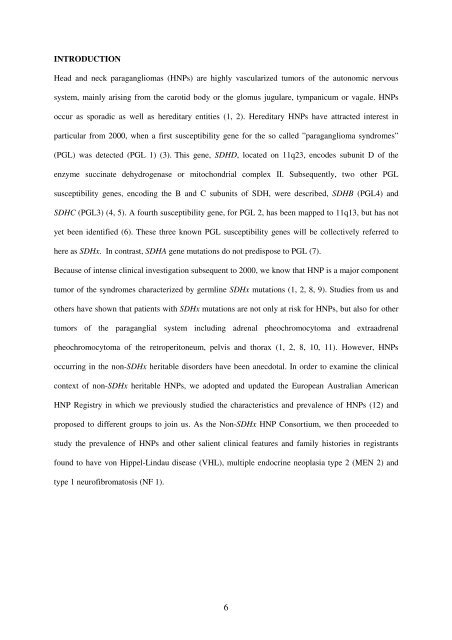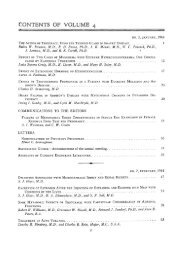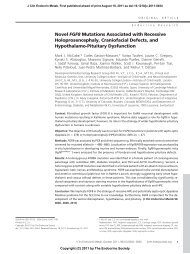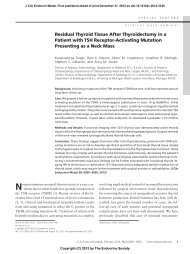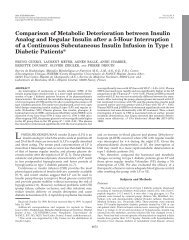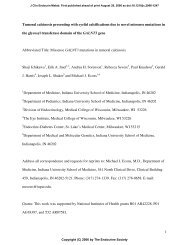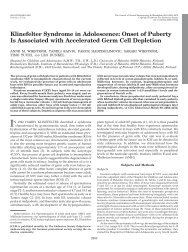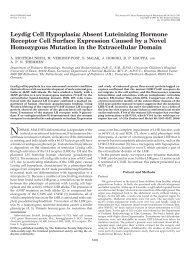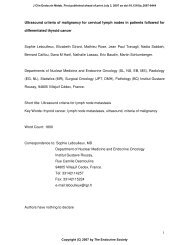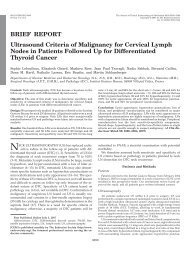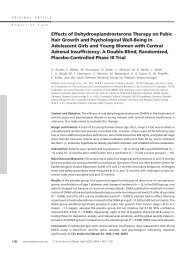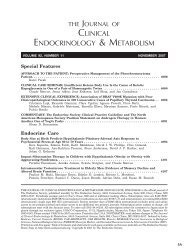Head and Neck Paragangliomas in Von Hippel-Lindau Disease and ...
Head and Neck Paragangliomas in Von Hippel-Lindau Disease and ...
Head and Neck Paragangliomas in Von Hippel-Lindau Disease and ...
You also want an ePaper? Increase the reach of your titles
YUMPU automatically turns print PDFs into web optimized ePapers that Google loves.
INTRODUCTION<br />
<strong>Head</strong> <strong>and</strong> neck paragangliomas (HNPs) are highly vascularized tumors of the autonomic nervous<br />
system, ma<strong>in</strong>ly aris<strong>in</strong>g from the carotid body or the glomus jugulare, tympanicum or vagale. HNPs<br />
occur as sporadic as well as hereditary entities (1, 2). Hereditary HNPs have attracted <strong>in</strong>terest <strong>in</strong><br />
particular from 2000, when a first susceptibility gene for the so called ”paraganglioma syndromes”<br />
(PGL) was detected (PGL 1) (3). This gene, SDHD, located on 11q23, encodes subunit D of the<br />
enzyme succ<strong>in</strong>ate dehydrogenase or mitochondrial complex II. Subsequently, two other PGL<br />
susceptibility genes, encod<strong>in</strong>g the B <strong>and</strong> C subunits of SDH, were described, SDHB (PGL4) <strong>and</strong><br />
SDHC (PGL3) (4, 5). A fourth susceptibility gene, for PGL 2, has been mapped to 11q13, but has not<br />
yet been identified (6). These three known PGL susceptibility genes will be collectively referred to<br />
here as SDHx. In contrast, SDHA gene mutations do not predispose to PGL (7).<br />
Because of <strong>in</strong>tense cl<strong>in</strong>ical <strong>in</strong>vestigation subsequent to 2000, we know that HNP is a major component<br />
tumor of the syndromes characterized by germl<strong>in</strong>e SDHx mutations (1, 2, 8, 9). Studies from us <strong>and</strong><br />
others have shown that patients with SDHx mutations are not only at risk for HNPs, but also for other<br />
tumors of the paraganglial system <strong>in</strong>clud<strong>in</strong>g adrenal pheochromocytoma <strong>and</strong> extraadrenal<br />
pheochromocytoma of the retroperitoneum, pelvis <strong>and</strong> thorax (1, 2, 8, 10, 11). However, HNPs<br />
occurr<strong>in</strong>g <strong>in</strong> the non-SDHx heritable disorders have been anecdotal. In order to exam<strong>in</strong>e the cl<strong>in</strong>ical<br />
context of non-SDHx heritable HNPs, we adopted <strong>and</strong> updated the European Australian American<br />
HNP Registry <strong>in</strong> which we previously studied the characteristics <strong>and</strong> prevalence of HNPs (12) <strong>and</strong><br />
proposed to different groups to jo<strong>in</strong> us. As the Non-SDHx HNP Consortium, we then proceeded to<br />
study the prevalence of HNPs <strong>and</strong> other salient cl<strong>in</strong>ical features <strong>and</strong> family histories <strong>in</strong> registrants<br />
found to have von <strong>Hippel</strong>-L<strong>in</strong>dau disease (VHL), multiple endocr<strong>in</strong>e neoplasia type 2 (MEN 2) <strong>and</strong><br />
type 1 neurofibromatosis (NF 1).<br />
6


